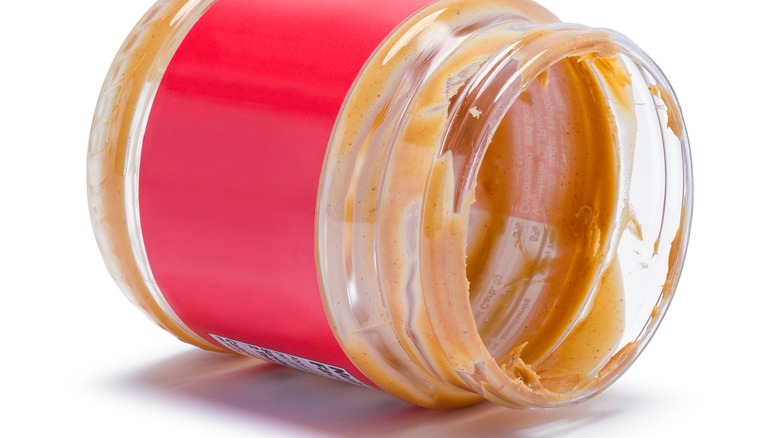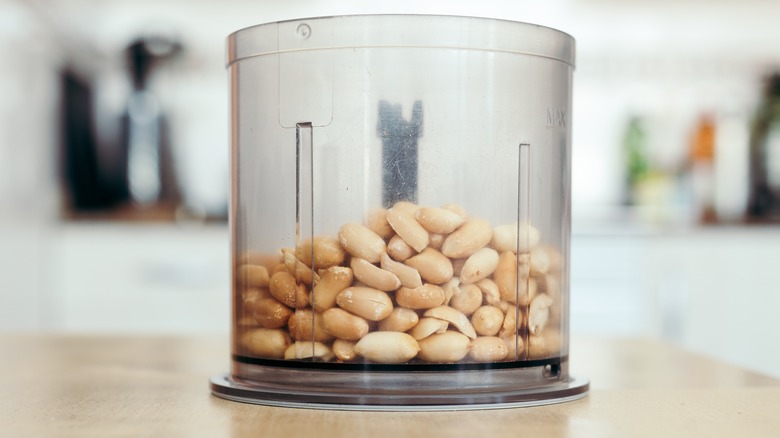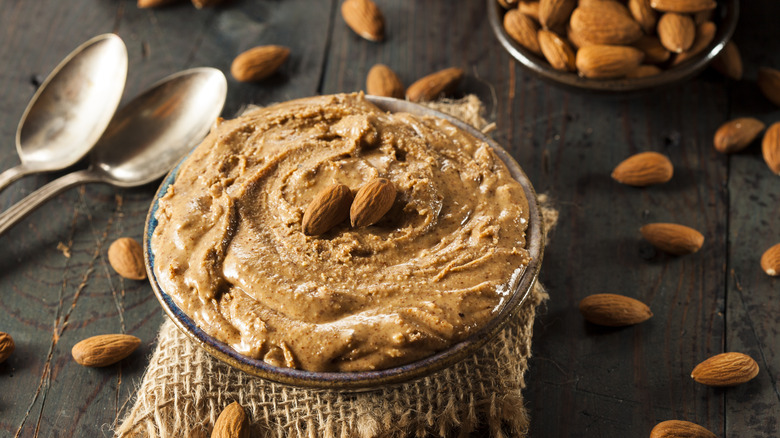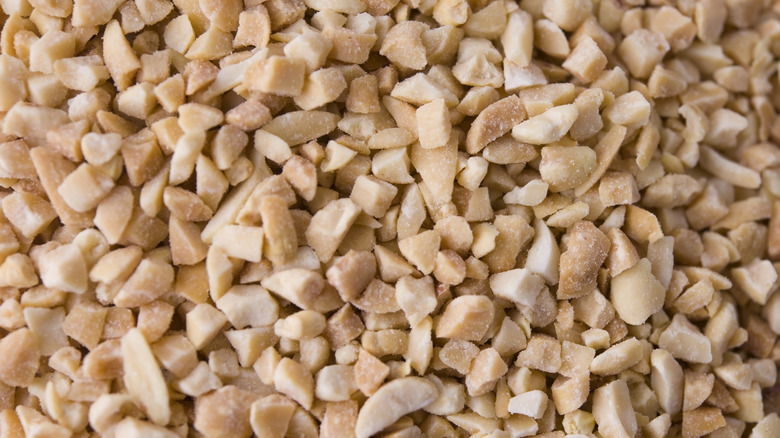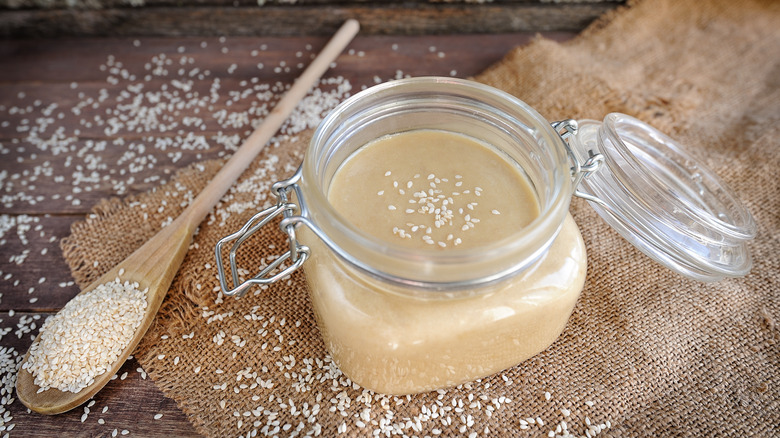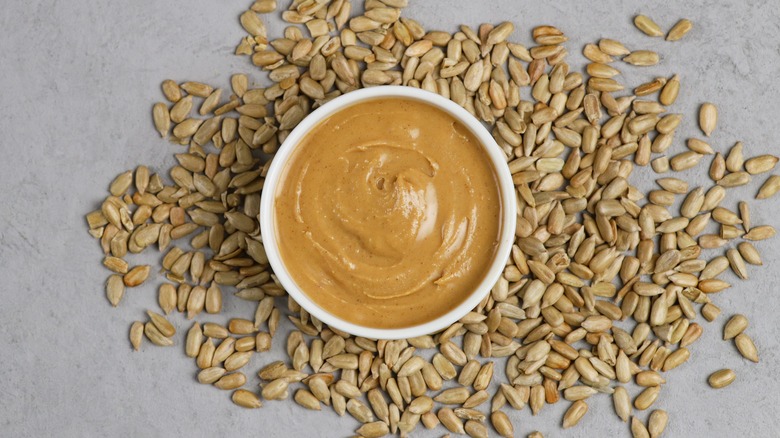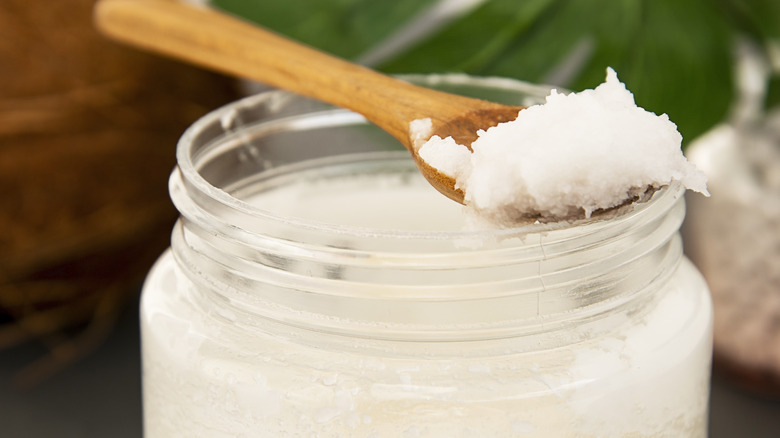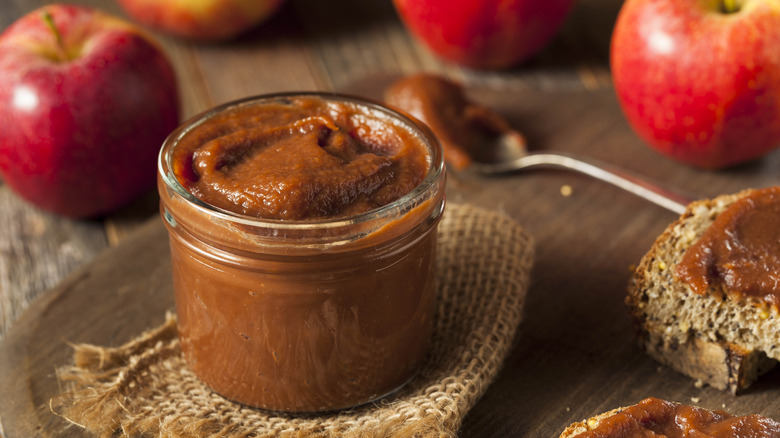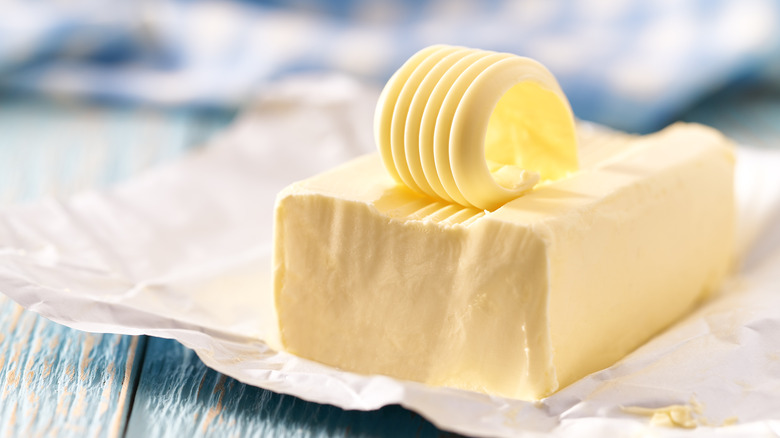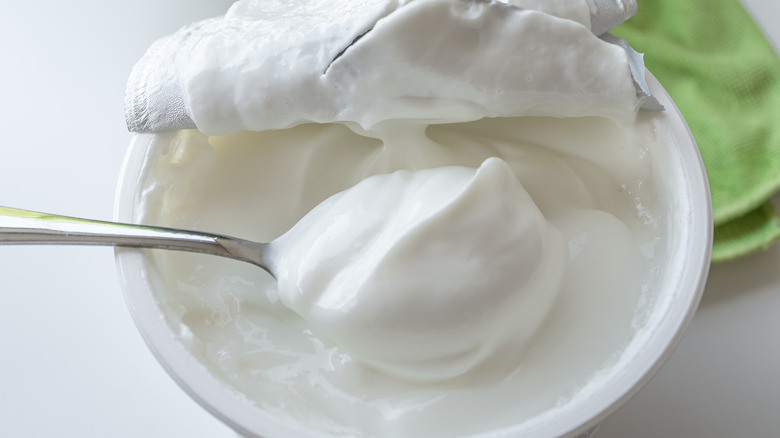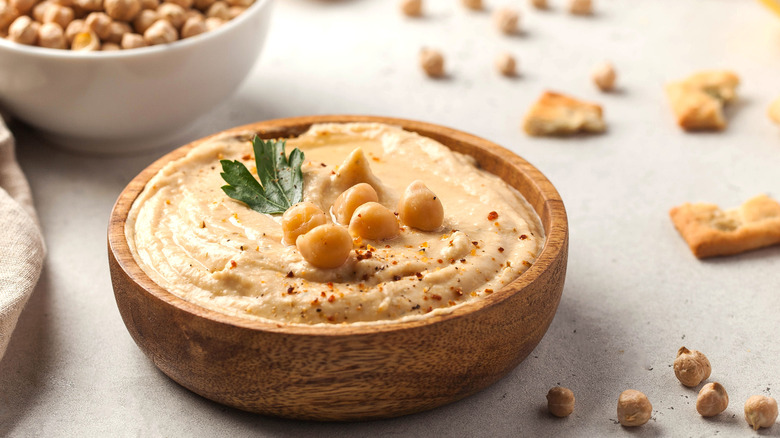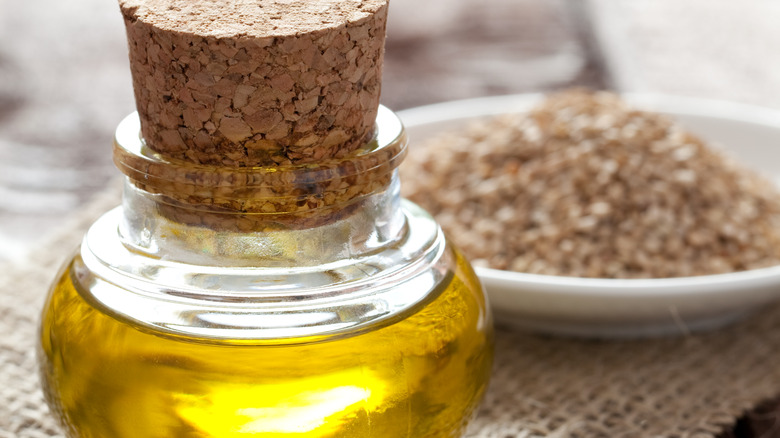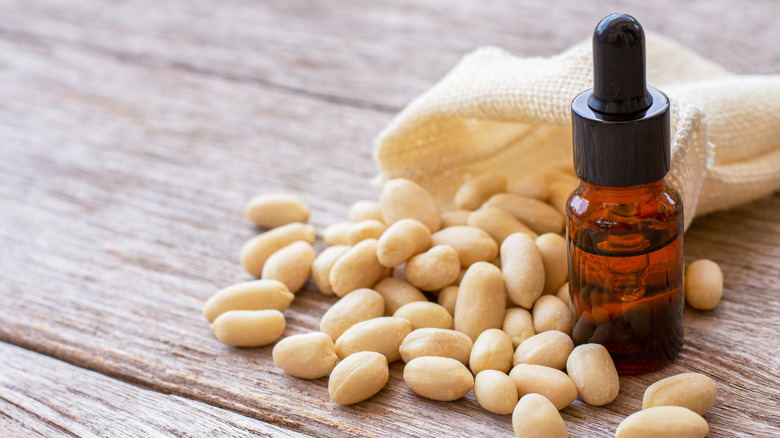What To Use When You're Out Of Peanut Butter
America loves peanut butter. We use peanut butter for sandwiches, baked goods, sauces, spreads, desserts, milkshakes, smoothies, and so much more. You can even use the last dribs from your jar of peanut butter to make a savory noodle dish.
But as with anything you are constantly using and enjoying, it is also easy to run out of peanut butter unexpectedly (such a sad time). You might forget the last batch of peanut butter pancakes you threw together, or your last Netflix binge when you enjoyed a few too many spoonfuls, right from the jar. Whatever the case, now you are totally in the middle of making peanut butter muffins and you have zero peanut butter on hand, and you don't have time to run out to the store in the middle of cooking. The next time this happens to you, don't fret. Just use one of these amazing — and tasty — peanut butter substitutions instead.
1. Make homemade peanut butter
There's something magical about lush, creamy peanut butter right from the jar. It's salty, it's savory, and yet, it's also sweet at the same time. It packs every flavor you want in an indulgent snack into a single bite. But here's the thing — you don't have to rely on manufacturers for this gooey goodness. You can also make peanut butter on your own, right at home. Try it sometime, either when you're in a crunch and out of peanut butter, or when you have a few minutes to leisurely experiment and play.
To whip up your own DIY peanut butter spread, all you need is a bunch of dry, roasted peanuts — around 2 cups ideally. Start by placing the peanuts in a food processor or high-powered blender. Next, use the pulse setting on the appliance to break the peanuts into a coarse powder or meal. Continue processing, scraping down the sides of the bowl as needed, until the peanuts begin to release their oils and the mixture becomes smoother. Don't rush it — this step can take several minutes. You can stop blending whenever your peanut butter reaches your desired thickness and consistency. For creamier peanut butter, you can also add 1 to 2 tablespoons of neutral-flavored oil, such as peanut or vegetable oil.
Like your peanut butter sweet? Blend in some maple syrup or honey. You can also add spices like cinnamon, flavored extracts, chili powder, coconut, sea salt, chocolate chips, and more.
2. Swap in another nut butter
When you're out of peanut butter, you want the next best thing — and in most cases, that will always be another type of nut butter. Fortunately, you have plenty of options to choose from. America's fascination with peanut butter has ensured that when you get to that aisle of your local grocery store, you have plenty of different kinds of butter to pick from, both peanut-based and non.
In most cases, almond butter should be your de facto substitution choice. It has a very similar sweet and nutty flavor profile to traditional peanut butter and the same thick consistency, so swapping one for the other tends to be a breeze. You can even substitute them in a 1-to-1 ratio, so you don't have to modify recipes at all. Just remember that almond butter is more prone to separation than its peanutty cousin, so make sure it has been stirred well before you put it to use.
Cashew butter is another great potential peanut butter replacement. It's just as creamy, but perhaps a bit milder, so you may not notice quite as much nutty flavor in whatever you're making. It's also more expensive, so it might be a better option if your recipe calls for a small amount of peanut butter vs a massive cup or more. Nut butter made with hazelnuts, pistachios, Macadamia nuts, and pecans are also incredible potential substitutions and can also be used in a 1-to-1 ratio in place of peanut butter.
3. Use chopped nuts
In lieu of homemade peanut butter or an alternative nut butter, sometimes all you need for a good peanut butter substitute is a bunch of peanuts themselves. This is especially true when you're using peanut butter in a recipe or dish for flavor more than actual creaminess or body. Take peanut butter muffins, for example. You couldn't just throw a few spoonfuls of chopped peanuts into your batter in place of peanut butter and call it a day — the muffins wouldn't rise and bake properly.
However, if you're making an indulgent banana nut smoothie, then chopped peanuts are a perfectly acceptable substitute for peanut butter. Similarly, if you're making Grilled Shrimp Pad Thai or Thai peanut noodles and craving some salty, nutty flavor in the dish, then crushed peanuts are a perfect replacement for that peanut butter you've run out of.
You can also use peanuts in place of peanut butter in pancake and waffle batter, stir-fry dishes, and soups and stews. You can even make this switch in a batch of cookies. Just change the recipe you're preparing from a standard peanut butter cookie recipe to a classic sugar cookie-style dessert instead. Then, fold as little or as much of the chopped nuts into your dough as you'd like before you put your cookies in to bake. The final product won't taste exactly like a peanut butter cookie, but it will be infused with loads of crunchy peanut flavor — the next best thing.
4. Try some tahini
Think back to the waves of nutty flavor you enjoyed the last time you snacked on a bowl of hummus or a side of savory baba ganoush. The peanut-like flavor in those dishes doesn't come from nuts; it comes from tahini, a popular Middle Eastern and Mediterranean spread made with ground sesame seeds. Whether you have a nut allergy and can't eat peanuts, or you've just used up all the processed peanut butter you had on hand, the important thing to remember is that this condiment is a fantastic substitute for peanut butter.
From its color to its consistency to its overall flavor, tahini is a doppelgänger for peanut butter in countless ways. It's versatile and can be used in sweet and savory dishes. It's packed with valuable nutrients. And it can be used in a 1-to-1 ratio in place of that creamy OG. For instance, you can swap tahini for peanut butter tablespoon-to-tablespoon to add vibrant nut flavor to salad dressings and sauces. You can also use tahini as a substitute for peanut butter in veggie dips, stir-fries, homemade granola and energy bars, and even breakfast bowls.
In fact, the only places you may not want to use tahini as a replacement for peanut butter is in sandwiches and homemade chocolate candies. Tahini's rich flavor may be too distinctive to pair with jam or jelly in a PB&J. It can also be bitter without added sweetener, so it doesn't always play well with rich chocolate.
5. Use a nut-free sunflower seed butter
Sunflower seed butter is an unusual culinary imposter. It's not a nut butter because it's not made from nuts — but it looks like one. Instead of being a nut-based product, as the name alludes to, it's a spread made from roasted sunflower seeds. It has a creamy texture and a slightly nutty flavor, reminiscent of peanuts but with a milder roasted taste. It also has a smooth, creamy texture similar to peanut butter, but slightly thinner.
As a spread, sunflower seed butter is intended for most of the same uses as peanut butter. It's excellent on toast, crackers, apple slices, or stirred into yogurt or oatmeal. It can be used as an ingredient in dips and sauces. And it's a beautiful substitute for peanut butter whenever you run out of the stuff.
Unlike tahini, sunflower seed butter has enough robust sweetness to pair well with chocolate. You can use it as a 1-to-1 replacement for peanut butter in cookies, cakes, and homemade candies. Baking brownies or blondies? Swirl 1 to 2 tablespoons of sunflower seed butter through the batter before you bake them in the oven. You can also replace peanut butter with sunflower seed butter in homemade energy balls. Mix your favorite assortment of dried oats, chocolate chips, nuts, and dried fruit — plus a drizzle of honey — and then add enough sunflower seed butter to hold everything together. Mix well and shape the "batter" into balls you can chill and eat later.
6. Add creaminess with coconut butter
Like sunflower seed butter, coconut butter is another condiment that's widely used for snacking. And it, too, is an excellent substitute when you're running low on peanut butter.
For those who have never tried it, coconut butter is essentially a creamy spread made from puréed coconut meat. While it may look similar to coconut oil, which is extracted from the flesh of fresh coconuts, it's not greasy. Instead, coconut butter contains both the oil and the fiber-rich flesh of the fruit. It has a rich, nutty flavor with a subtle sweetness and a creamy texture similar to peanut butter. On its own, coconut butter can be used as a spread or topping. As a replacement for peanut butter, its uses are even more varied.
Swap it 1-to-1 with peanut butter in any and all baking recipes, from muffins and cookies to brownies and more. You can also use coconut butter in smoothies and milkshakes — it's amazing paired with chocolate ice cream and some milk and blended to frothy perfection. Coconut butter also works well in all sorts of batters, from pancakes and waffles to quick breads and even donuts. Similar to peanut butter, you can also add it to yogurt, dips for fruit, savory stir-fries, and noodle sauces. While it does have the body and richness of peanut butter, it is less salty and nutty. So, you may want to pair it with some crumbled peanuts for an even nuttier flavor in your dishes.
7. Consider jam or jelly — or even apple butter
Grape jelly, strawberry preserves, and apple butter will never be peanut butter. We get it. They aren't salty. They aren't fatty. They aren't packed with protein like peanuts are, and they won't fill you up in the same way. But, if you're out of peanut butter and looking for a quick substitution, they do have some appealing traits that can help you out in a pinch.
Jams and jellies of all types are great for adding sweetness to dishes, just like peanut butter can. They can also provide moisture in a recipe, helping to keep baked goods soft and sauces, well, saucy. And they're packed with deep, complex flavors that can add a burst of tang and acid to a recipe. Your final dish isn't going to end up tasting "nutty," but it will taste good, and that's what matters.
When you don't have peanut butter available, jams and jellies are great alternatives for sandwiches, toast, crackers, or mixing with oatmeal or yogurt. They can add rich, delicious flavor to cookies, crepes, and smoothies. Even in savory dishes like glazes for meat or vegetables, these fruit-based spreads can add unique mouthwatering flavor to your final dish in much the same way peanut butter would. Apple and pear butter, in particular, with their naturally thicker and chunkier consistency (due to the presence of pulp in the spread), are an especially worthwhile option to consider when your peanut butter supply is kaputt.
8. Swap in some regular salted butter
Sometimes, favorite recipes and dishes don't call for peanut butter due to its rich peanut flavor. Sometimes, peanut butter is only in a recipe because of the rich creaminess it provides. It adds fat, complexity, and depth to a food's flavor profile. In these cases, when peanut butter isn't an option, the next best thing might just be dairy-based butter itself. While even the best quality, organic, imported high-end butter isn't going to make any dish taste nutty, even the regular butter we all have on hand can be a great way to add richness and depth of flavor to recipes.
First, a word of caution. Because peanut butter has a much more chunky and substantial presence in foods, you probably shouldn't substitute dairy-based butter for peanut butter when baking. Use one of the other options, like a different nut-based butter or sunflower seed butter instead. But for savory dishes in particular, anything you would have used peanut butter in can benefit from the addition of plain butter, as well.
Take a chicken or beef satay. If you don't have peanut butter, dairy-based butter is an excellent alternative for prepping these grilled wonders. You can also swap regular butter for peanut butter in soups, casseroles, sauces, Thai curries, stir-fries, Pad Thai, ramen, and any other noodle-based dishes you're cooking up. Again, you won't have that nutty taste, but you will get the salty richness that makes butter so marvelous.
9. Try a dairy substitute like Greek yogurt or cream cheese
There's nothing about Greek yogurt or cream cheese that should have you confused either for peanut butter. But when you reach for the peanut butter and find an empty jar, both can help you out of your jam. Like butter, the secret here isn't the flavor of these dairy staples. For salty, nuttiness, you need to look at other options. But if you need moist, rich, velvetiness, you're in luck.
From dips to shakes to salad dressing, Greek yogurt and cream cheese can both be used 1-to-1 as a replacement for peanut butter. These lush favorites are also mouthwatering additions to pasta and noodle dishes, creating the same kind of decadent creaminess you would get from peanut butter. Use can also use Greek yogurt or cream cheese as a base for luscious sauces served over meat or poultry dishes. They add a silky smoothness, minus peanut butter's nutty intensity. And if you're making a sandwich, cream cheese and jelly — a CC&J if you will — might just become a new fave.
10. Experiment with hummus
We already detailed how tahini can be a great substitute for peanut butter, but don't count out hummus as well — especially since it's essentially tahini mixed with mashed chickpeas. More than just a snack or dip, hummus is a versatile ingredient that can be used in a wide variety of foods, including as a topping for salads, in savory bowl meals, and atop grilled meats, in much the same way as you might use peanut butter.
Making a savory peanut butter and greens sandwich with pickles? Spread hummus on your bread instead and then layer together the rest of your sandwich as normal. Thai-style chicken pizza with a peanut-based sauce is a growing trend and a popular menu item in many places. And if you're making your own and out of peanut butter, hummus is an excellent alternative. You can also use hummus in the place of peanut butter in stuffed celery, leafy garden salads, on rice cakes and toast, and even in Asian-influenced wraps. Just keep it away from your cookies and chocolate — there are better peanut butter replacements when it comes to dessert.
11. Use a drizzle of sesame oil
Finishing oils like truffle oil and sesame oil sometimes get a bad rap. It's no wonder. When used with abandon, their intense flavors can overpower other foods. But if you're out of peanut butter and looking to add that same pronounced peanut flavor to something you have on the stove or in the oven, sesame oil can work miracles.
This powerful oil (which is extracted from ground sesame seeds) has a robust, nutty, roasted flavor and aroma. It's like the goodness of peanut butter concentrated and minus any hint of sweetness. While sesame oil won't make your foods creamy, it will add potent nutty depth to their flavor profile. You can add it to marinades, dipping sauces, vegetable glazes, salad dressings, and more. If you like to stir a heaping spoonful of peanut butter into a stir-fry or noodle dish, a drizzle of sesame oil is the next best thing. Just go easy when using it. You can always add more. But if you splash on too much, that peanut butter-like essence could prove overwhelming.
12. Add a few drops of a flavored extract
When you're out of peanut butter, don't forget the value of a good flavored extract. Primarily designed for baking and uses like frosting or adding flavors to various batters, cooking extracts can also be a brilliant way to infuse the nutty flavor of peanut butter into foods when you don't have natural peanut butter on hand.
Although you won't find it in all markets, flavored "peanut butter" extract exists and is obviously an ideal flavor replacement for peanut butter spread. But you can also get a similarly rich, savory, nutty quality from almond, maple, coconut, chocolate, and especially hazelnut-flavored extracts. If you choose to use one, the first rule to remember is that a little flavor goes a long way, so start small. Add a drop or two of the flavor to the food, taste it if you can, and then add more as needed until you reach your desired flavor intensity.
Extracts are an incredible option for adding a nutty flavor to a cookie batter. They work well in smoothies, hot or cold oatmeal dishes, pancakes, milkshakes, and puddings. You can also use a flavored extract instead of peanut butter when making a salad dressing, a boldly flavored fruit salad, and — of course — cakes and icings. On the flip side, if your dish needs a thick, creamy texture more than just nutty flavor, it's better to skip extracts entirely and go with a different substitute instead. Good luck.

